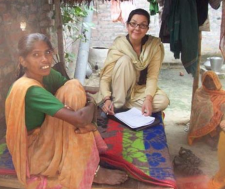A REPORT ABOUT NEED FROM AN INTERNATIONAL RESEARCH SCHOLAR FROM UNIVERSITY OF ZURICH, SWITZERLAND.

My encounter with NEED resulted when I first got in touch with a National Bank of Agriculture and Rural Development (NABARD) official about a case study with their loan linkage programme, which is assessed to be the largest in the world. Since NABARD is not directly into micro-lending, they recommended that I work with one of their partner NGOs who are much active on the microfinance front. And so NEED was recommended to me as the case study which was a part of my dissertation project on, “The Political Economy of Microfinance: Case studies from South Asia” at the Zurich University.
Initially I intended to draw a sample of some 50 households from the rural and urban UP and conduct interviews with the women borrowers and their male guardians/ spouse to see how (and who) the micro lending operations of NEED are hindered (hinders) or aided (aids) given the whole societal, communal and familial set up. However, the CEO of NEED, Mr. Anil Singh, insisted that I draw at least some 20% of the data from the adjoining state of Bihar as part of their interest (and compensation) for helping me out for my work with them. Though I was a little hesitant (due to lack of funds and time) of this, but eventually gave in to his suggestion and today am happy to have done so.
I spent the next 9-10 weeks visiting the clients and having in depth interviews with them and their spouses/ male guardians. I started with the sub urban slums of Lucknow in Alambaagh and Jankipuram. From there I moved on to rural Mehmoodabad in the Sitapur district, where I was confronted with a totally different set up and peer dynamics than in the sub urban set up.
Many things were simply mind boggling and like almost everything I saw in India amazing and disturbing at the same time. The fact that living conditions in the rural front were very different from that of the urban; like having no running water or the simple comfort of having a toilet in your house or where electricity is supplied for only a couple of hours in a day. The loan officers (livelihood support advisors (LSAs) who were appointed to work in the areas were usually not from the area themselves, nonetheless, it was simply humbling and commendable to see how hard and long they worked under Prof. Aliya Khawari is at one of the village in UP and interacted with MF supported clientele such living conditions. Their working days were sometimes 10-12 hours long and very often they had to forgo their weekends if they were to have the collections on time, as microfinance is a very tough market, needing a lot of surveillance and a days delay could result in loss of recollections. Moreover, in contrast to the sub urban UP, where NEED basically lent to joint liability groups (JLGs), the rural areas were approached mostly with better interest rates for the loans to the already established self help group (SHG). Microfinance aside, the SHG formation served the purpose of awareness, confidence building and community development among the women in particular much better than did the JLG lending alone. Read More
RBI Reg. No. N-14.03356, CIN :U65100DL2015PTC287435
Copyright © 2017-18 NEED LIVELIHOOD MICROFINANCE PRIVATE LIMITED (NLMPL) All Rights Reserved.
